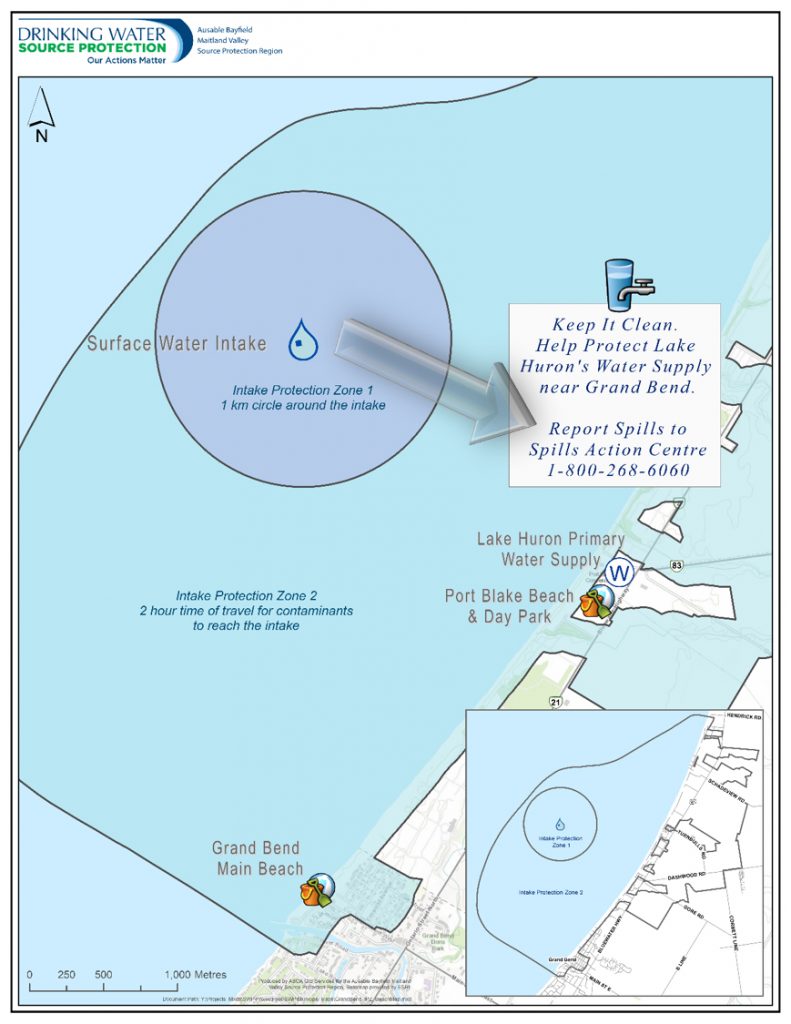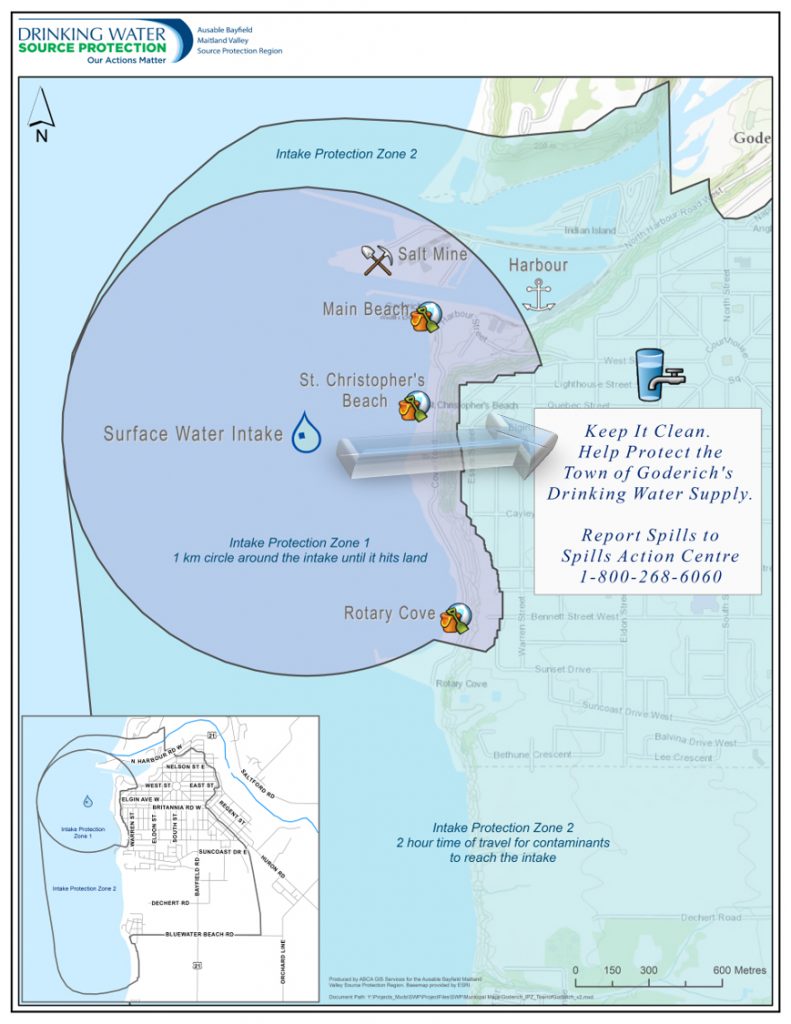There are two Great Lakes intakes in the Ausable Bayfield Maitland Valley Drinking Water Source Protection Region. The two local lake intakes provide the drinking water source for hundreds of thousands of people.
There are no significant drinking water threat activities assessed at the two intakes in this region but we ask you to have regard for policies in source protection plans that have been developed locally and approved provincially. The plans provide you with actions you can take to reduce risk to these water sources.
The two intakes are:
- Lake Huron Primary Water Supply System in Port Blake, north of Grand Bend
- Goderich water intake in the Town of Goderich.
To learn more please download these fact sheets at these links:
- Fact sheet – Lake Huron Primary Water Supply – Intake Protection Zones – Drinking Water Source Protection Fact Sheet
- Goderich – Intake Protection Zones and Drinking Water Source Protection
Hundreds of thousands of people, in Canada and the United States, get their drinking water from Lake Huron.
Raw water is captured in this region, for treatment, from intakes in Goderich and near Grand Bend (the Lake Huron Primary Water Supply System intake in Port Blake). The water is then treated.
The volume of water these Great Lakes intakes draw from creates a low vulnerability score. Therefore no activities have been deemed as significant threats to municipal drinking water sources in these zones. In the Maitland Valley and Ausable Bayfield source protection areas, activities assessed as significant threats to drinking water are only present in some of properties in municipalities where the drinking water systems use groundwater as their source.
Your local source protection committee has developed source protection plans which have been approved by the Province of Ontario and are in effect. The policies in the plans are not mandatory in surface water intake protection zones of this region – as threat activities are not assessed as significant – but you are encouraged to consider ways you can help protect your drinking water that has Lake Huron as its source.
Here are some ways to protect drinking water sources at work:
Here are some ways to protect drinking water sources at home:
Protecting the area around a surface water intake means protecting the surrounding water and, in most cases, the land that surrounds the water. This area of water and land is known as an intake protection zone, or IPZ. The Province of Ontario has required that several intake protection zones be identified:
1) For the area immediately adjacent to the intake
2) For the area further upstream where a spill might reach the intake before the plant operator can deal with it
3) An area that includes a larger part of the source protection area.
Intake protection zones may include properties around the lake or on smaller feeder rivers or tributaries.
The area of water and land in an intake protection zone is determined, under the Ontario Clean Water Act, 2006, by factors such as the time it would take any material spilled in, or near, the river or lake, to reach the water intake. This is called the time of travel. For the purposes of establishing the second intake protection zone, technical staff examine a minimum time of travel of two hours, although it could be longer if the water treatment plant operator response time is longer.
Click on the Plans tab for copies of your local source protection plans and for ways you can help to protect drinking water sources.
Here are some benefits to keeping contaminants out of Great Lakes water sources:
- Protecting human health – keeping pathogens and chemicals out of drinking water sources, to prevent illness or death
- Not having to find new drinking water sources when old ones become contaminated
- Avoiding the need or cost to clean up contaminated water
- Reducing the cost of water treatment
- Ensuring a long-term supply of clean water
- Ensuring a reliable water supply and positive climate for economic growth
What is drinking water source protection?
Source water is the raw, untreated water we take from lakes, rivers, and underground aquifers – for treatment – to supply people with drinking water. Drinking water source protection, or source water protection, means protecting these sources of drinking water from contamination and overuse. The focus is on prevention.
Protection of public health is a benefit of drinking water source protection in intake protection zones.
Prevention of drinking water contamination in the first place costs much less than cleaning up water after it has been contaminated.
About Intake Protection Zones and the Lake Huron Primary Water Supply
From where does the Lake Huron Primary Water Supply draw its source of water for treatment?
The water supply for the Lake Huron Primary Water Supply is drawn from Lake Huron at Port Blake (near Grand Bend) about 2.5 km offshore at a depth of nine metres. This intake and water treatment plant serves most towns and hamlets from Bayfield to London – about 400,000 people. The area one kilometre around the intake is called the Intake Protection Zone 1 or IPZ-1. Where the water takes two hours to reach the intake it is Intake Protection Zone 2 or IPZ-2. These are areas where the water supply is most vulnerable. If you notice a spill, please call the Spills Action Centre at 1-800-268-6060.
About Intake Protection Zones and the Town of Goderich Intake
From where does the Town of Goderich draw its water for treatment to provide drinking water?
The water supply for the Town of Goderich is drawn from Lake Huron. The area one kilometre around the intake is called the Intake Protection Zone 1 or IPZ-1. The area where water takes two hours to reach the intake is called Intake Protection Zone 2 or IPZ-2. These are areas where the municipal water supply is most vulnerable. If you notice a spill, please call the Ontario Spills Action Centre at 1-800-268-6060.
To learn more please go to www.sourcewaterinfo.on.ca or call 1-888-286-2610
You can also get information on the provincial website:
You may also visit the Source Protection Information Atlas:
This content is for local information purposes, is provisional, and subject to change.
Drinking Water Systems
- Atwood Drinking Water System
- Auburn Drinking Water System
- Benmiller Drinking Water System
- Belgrave Drinking Water System
- Blyth Drinking Water System
- Brucefield Drinking Water System
- Brussels Drinking Water System
- Century Heights Drinking Water System
- Clinton Drinking Water System
- Dungannon Drinking Water System
- Gowanstown Drinking Water System
- Harriston Drinking Water System
- Huron Sands Drinking Water System
- Kelly Drinking Water System
- Listowel Drinking Water System
- Lucknow Drinking Water System
- McClinchey Drinking Water System
- Molesworth Drinking Water System
- Palmerston Drinking Water System
- S.A.M. Drinking Water System
- Seaforth Drinking Water System
- Vandewetering Drinking Water System
- Varna Drinking Water System
- Whitechurch Drinking Water System
- Wingham Drinking Water System
- Great Lakes Surface Water Intakes






